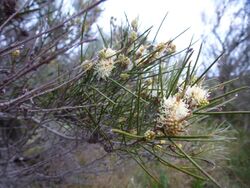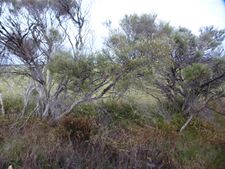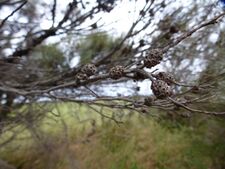Biology:Melaleuca osullivanii
| Melaleuca osullivanii | |
|---|---|

| |
| Scientific classification | |
| Kingdom: | Plantae |
| Clade: | Tracheophytes |
| Clade: | Angiosperms |
| Clade: | Eudicots |
| Clade: | Rosids |
| Order: | Myrtales |
| Family: | Myrtaceae |
| Genus: | Melaleuca |
| Species: | M. osullivanii
|
| Binomial name | |
| Melaleuca osullivanii Craven & Lepschi[1]
| |
Melaleuca osullivanii is a plant in the myrtle family, Myrtaceae and is endemic to the south-west of Western Australia. It was first formally described in 2004 after a review of the broombush group, Melaleuca uncinata. It differs from others in the group by having leaves that are fine and circular in cross section. The closest other broombrush is Melaleuca hamata whose leaves are 0.8–1.6 mm (0.03–0.06 in) in diameter compared to 0.7–0.9 mm (0.03–0.04 in) for this species.
Description
Melaleuca osullivanii is shrub growing to 3 m (10 ft) tall with flaky, papery bark. Its leaves are 28–73 mm (1–3 in) long, 0.7–0.9 mm (0.03–0.04 in) wide, linear in shape and oval to almost circular in cross section tapering to a point or with a bristle on the end.[2][3]
The flowers are creamy white and are arranged in heads containing 4 to 9 groups of flowers in threes. The petals are oval to almost circular, 0.7–1.2 mm (0.03–0.05 in) long and fall off soon after the flower opens. The stamens are arranged in five bundles around the flower, each bundle with 3 to 5 stamens. Flowering occurs in November and December and is followed by fruit which are woody capsules tightly packed together so that they appear like a single oval-shaped fruit 6.5–8 mm (0.26–0.31 in) in diameter.[2]

Taxonomy and naming
Melaleuca osullivanii was first formally described in 2004 by Lyndley Craven and Brendan Lepschi in Australian Systematic Botany.[4][5] The specific epithet (osullivanii) is a reference to Wayne O'Sullivan who has contributed to studies of Melaleuca species in the field.[2]
Distribution and habitat
This melaleuca occurs in and between the Perth, and Busselton districts[2] in the Jarrah Forest and Swan Coastal Plain biogeographic regions.[6] It often grows in sand in association with other heathy species of Melaleuca, Hakea, Grevillea and introduced grasses in areas close to the coast that are wet in winter.[2][6]
Conservation
Melaleuca osullivanii is listed as "not threatened" by the Government of Western Australia Department of Parks and Wildlife.[6]
References
- ↑ "Melaleuca osullivanii". Plants of the World Online. https://powo.science.kew.org/taxon/urn:lsid:ipni.org:names:60434416-2.
- ↑ 2.0 2.1 2.2 2.3 2.4 Brophy, Joseph J.; Craven, Lyndley A.; Doran, John C. (2013). Melaleucas : their botany, essential oils and uses. Canberra: Australian Centre for International Agricultural Research. p. 261. ISBN 9781922137517.
- ↑ Byrne, Margaret. "Broombush complex". Western Australian Government Department of Parks and Wildlife. http://www.dpaw.wa.gov.au/images/documents/conservation-management/wetlands/issue_13.pdf. Retrieved 5 June 2015.
- ↑ "Melaleuca osullivanii". APNI. https://biodiversity.org.au/boa/instance/apni/589520. Retrieved 5 June 2015.
- ↑ Craven, Lyn A.; Lepschi, Brendan J.; Broadhurst, Linda; Byrne, Margaret (2004). "Taxonomic revision of the broombush complex in Western Australia (Myrtaceae, Melaleuca uncinata s.l.)". Australian Systematic Botany 17 (3): 265–266. doi:10.1071/SB04001. http://www.publish.csiro.au/paper/SB04001.htm. Retrieved 5 June 2015.
- ↑ 6.0 6.1 6.2 "Melaleuca osullivanii". FloraBase. Western Australian Government Department of Parks and Wildlife. https://florabase.dpaw.wa.gov.au/browse/profile/20297.
Wikidata ☰ Q10969613 entry
 |


